How Do I Create and Use Windows Restore Point in Windows 10/8/7 [Beginners' Guide]
This page mainly tells that is Windows Restore Point, why do you need it, and show you how to create and use the Windows Restore Point in Windows 10/8/7.
If you are looking for a reliable way to protect your OS and computer from OS update failure or computer crash error, creating a Windows Restore Point is the best solution. Let's start!
PAGE CONTENT:
- What Is Windows Restore Point
- How to Create a Restore Point in Windows 10/7
- How Do I Restore (Windows 10) Computer to an Earlier Date (Use Restore Point)
- Windows Restore Point vs Windows OS Backup, Which Is Better
- How to Backup Windows (10) OS with Windows Backup Software
What Is Windows Restore Point?
Briefly, a Windows Restore Point is a backup image of Windows OS, configuration, and settings. It helps to restore Windows OS to an earlier date when the restore point was created. Windows Restore Point is also called System Restore Point.
More details about Windows Restore Point:
| Windows Restore Point Content | Backup Frequency | Supported Windows OS |
|---|---|---|
|
Once a day by default |
|
What Does Windows Restore Point Do:
- Undo unwanted system changes - such as to revert Windows to an earlier date.
- Protect OS from system crash, like Windows 10 update failure.
- Restore computer from Windows 10 BSOD error, boot failure error.
- Save Windows from application crash, virus attack.
- Restore applications or lost files from a previous restore point.
So how to create a Windows Restore Point to protect the computer, installed applications? In the next part, we'll take Windows 10 as an example to show you the process of creating Windows 10 restore point on your own.
How to Create a Restore Point in Windows 10/7
Solution Source: support.microsoft.com
Step 1. Press Windows + S keys, type create a restore point in the search box.
Click to open it in the control panel.
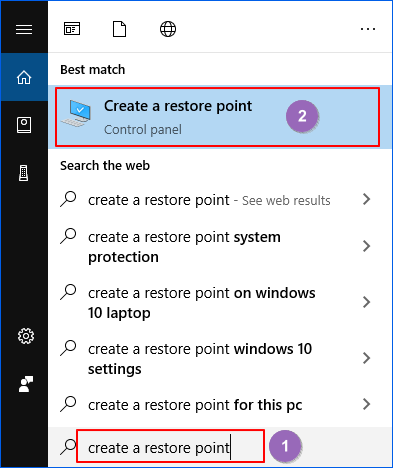
Step 2. On the System Protection tab, click "Create".
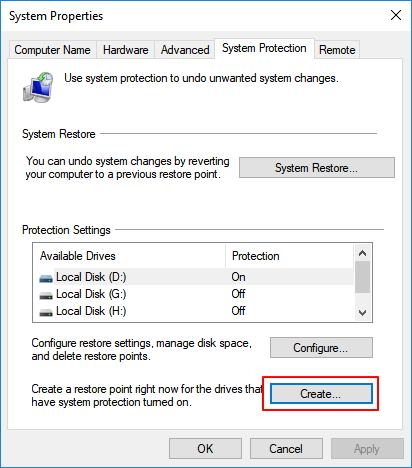
Step 3. Type a description of the restore point and click "Create".
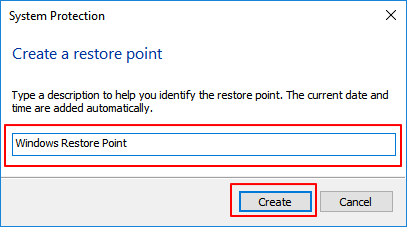
Step 4. Click "Close" when System Protection pops up a note, saying "The restore point was created successfully".
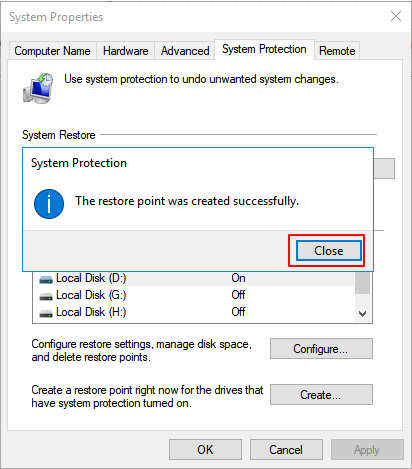
Note that the process also works to help you create a Windows Restore Point in Windows 8/8.1.
As for Windows 7, follow the tips below to create the restore point:
1. Click "Start" > "Control Panel" > "System and Security" > "System".
2. Go to the System Protection tab > click "Create".
3. Name the restore point, click "Create".
4. Click "Close" when Windows tells restore point was created successfully.
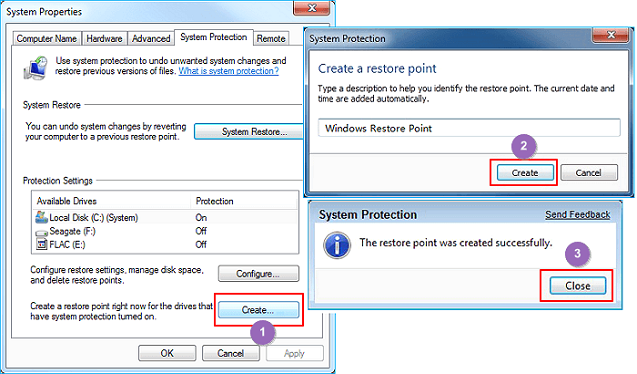
When you finish creating the restore point on your computer, you can perform a System Restore or revert Windows 10/7 to a previous date at any time. How to use it? Check the next tutorial guide.
How Do I Restore (Windows 10) Computer to an Earlier Date
Step 1. Press Windows + S keys, type control panel in the search box, and click to open it.
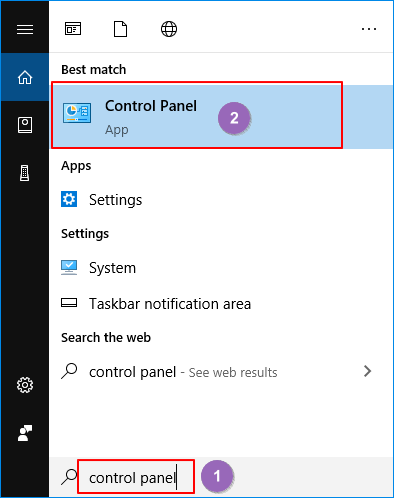
Step 2. On Control Panel, click "Recovery" > "Open System Restore".
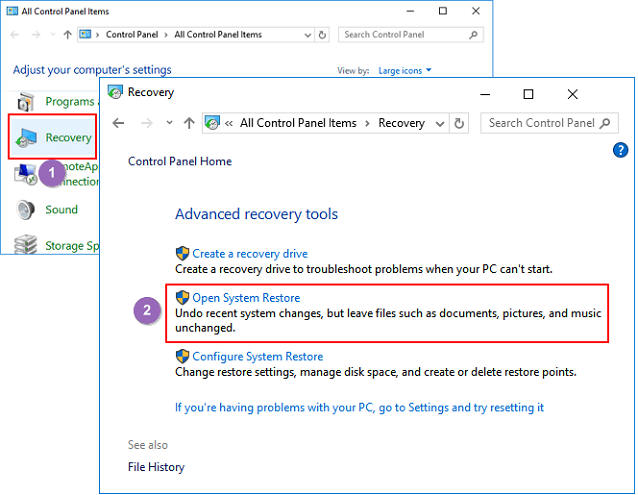
Step 3. Click "Next" on the Restore system files and settings window.
Step 4. Select the latest or an earlier Windows restore point that you created on an earlier date, select "Scan for affected programs".
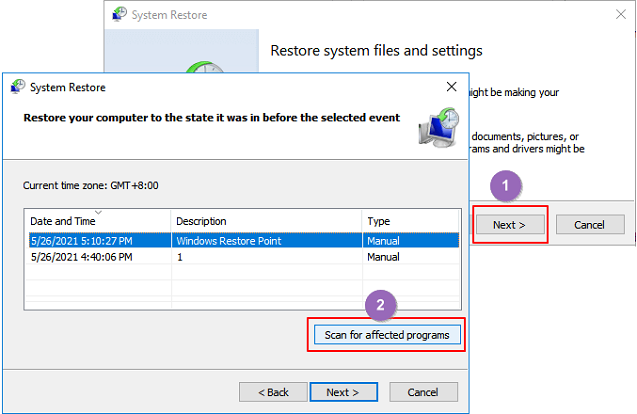
Step 5. If you see a list of items that will be deleted if you use the selected restore point.
Back up these affected items to an external hard drive first.
Step 6. Then, click "Close" > "Next" > "Finish".
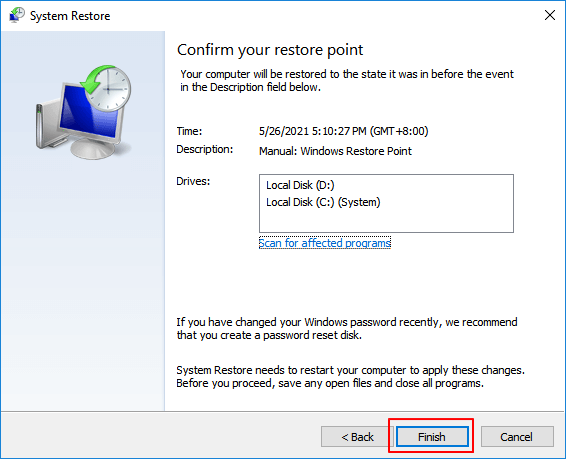
How to Undo System Restore in Windows 10/8/7
According to different Windows Operating Systems, the ways to undo System Restore are variable. And here you can follow the specific methods on your Windows OS for a guide now.
Windows Restore Point vs Windows OS Backup, Which Is Better? Pros & Cons
According to some Windows users, there is another easier solution to protect your data, applications, and even Windows system. It is to create Windows OS backup via a third-party Windows system backup software.
So what's the difference between Windows Restore Point and Windows OS backup? Check the Pros and Cons of these two solutions:
| Which Is Better | Windows Restore Point | Windows OS Backup |
|---|---|---|
| Pros |
|
|
| Cons |
|
|
Which is better? According to the comparison table, Windows OS backup saves the C drive space and won't be removed when you did some configuration changes to the computer.
Reliable Windows backup software - Qiling Backup is here to help.
Your Effective Backup Software
- Avoid System Restore Point Not Working
- Fix System Retore Failed & Did Not Complete error.
- Back up Windows OS, apps, and C drive files in only a few simple clicks.
- Clone OS - Migrate OS to HDD/SSD, Clone and upgrade hard drive.
Bonus Tip: How to Backup Windows (10) OS with Windows Backup Software
#1. Back Up Windows 10 OS:
Step 1. To backup only Windows 10 on your computer, please directly choose the option "System backup" on the "Backup and recovery" page.
Step 1. Connect the external hard drive to your computer and make Windows recognize the drive. Now launch Qiling Backup and click "System Clone".

Step 2. In the next window, where you can customize your own Windows 10 backup by choosing a backup location(HDD, USB hard disk, network drives, Cloud drives...), adding a plan name and text description to it.
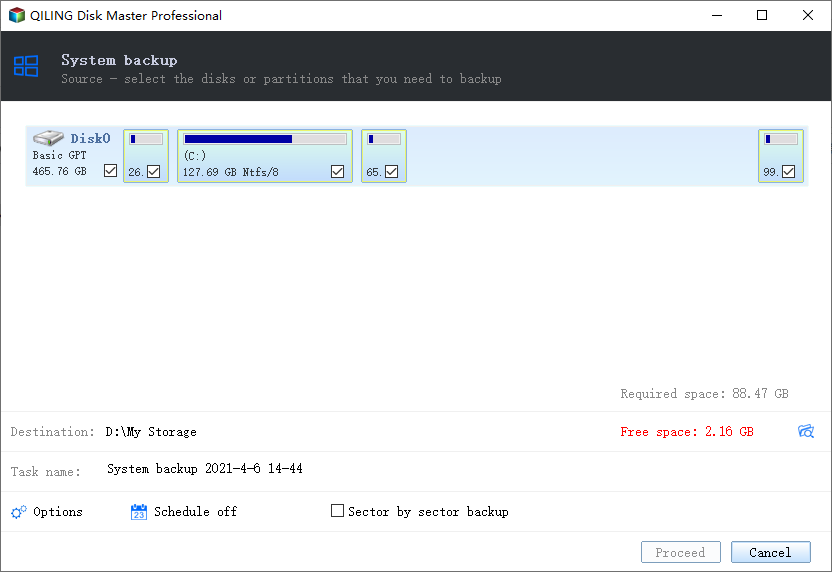
Since it's about backing up OS, it's significant to turn on the "Schedule", where you can enable an automatic Windows 10 backup at a set time like daily, monthly...or upon an event, telling the Windows 10 backup to start when system startup, system shutdown, user logon or user log off.
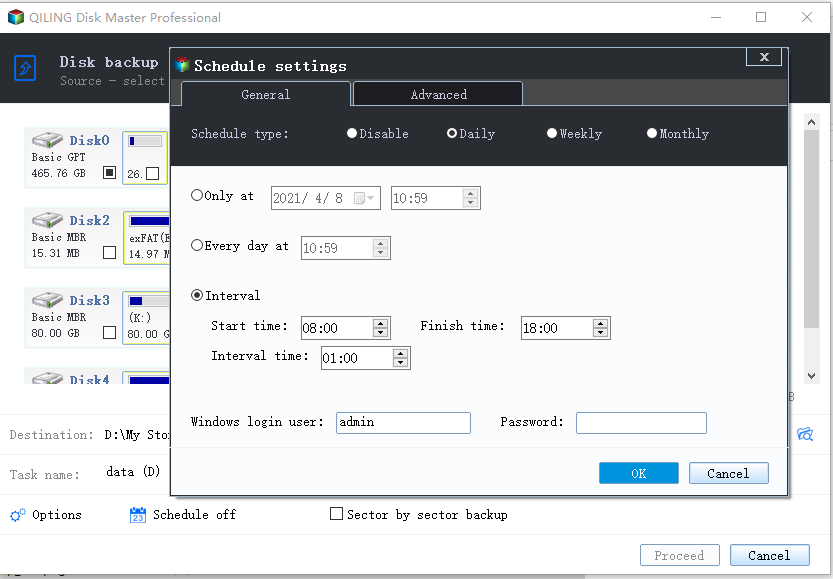
Step 3. Once all the basic settings were made, click "Proceed". Wait for a while you will create a full Windows 10 backup to protect your system from unexpected disasters.
Note: To backup Windows 10 to an external storage device, you must ensure that the storage device has been correctly connected to your computer in advance. Click the "Browse" button in the "Destination" area, you can choose the connected hard disks as a backup location. Also, the software supports many more paths to save your Windows 10 backup, including the cloud devices of OneDrive, GoogleDrive and DropBox, and Network/NAS devices.
#2. Restore Windows 10 To An Earlier Date via OS Backup Image
If you need to revert Windows OS to a previous state, you can apply Qiling Backup and restore system with the OS backup image.
Step 1. Open Qiling Backup, click the "Recovery" button on System Backup column.
Or click "Browse to Recover" to select the system backup you created in advance.
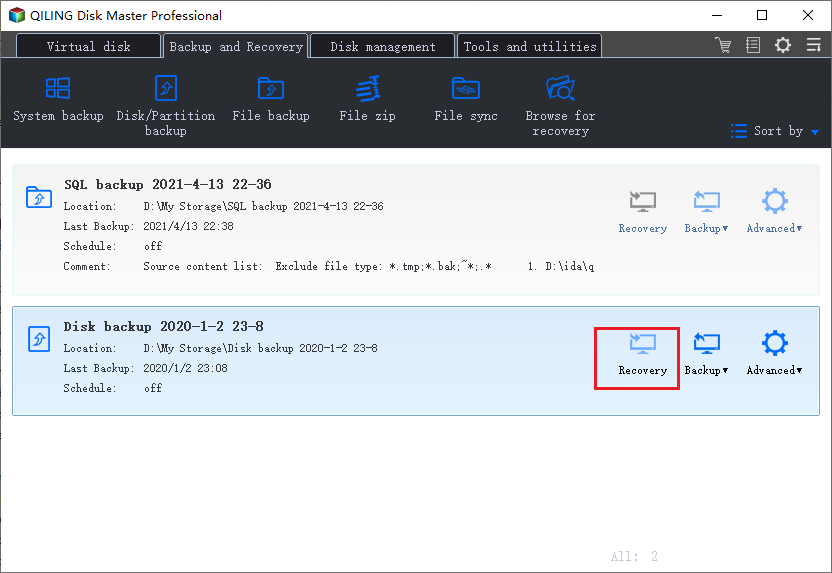
Step 2. Choose one History version of the backup image, after confirming the contents, click the "Next" button.
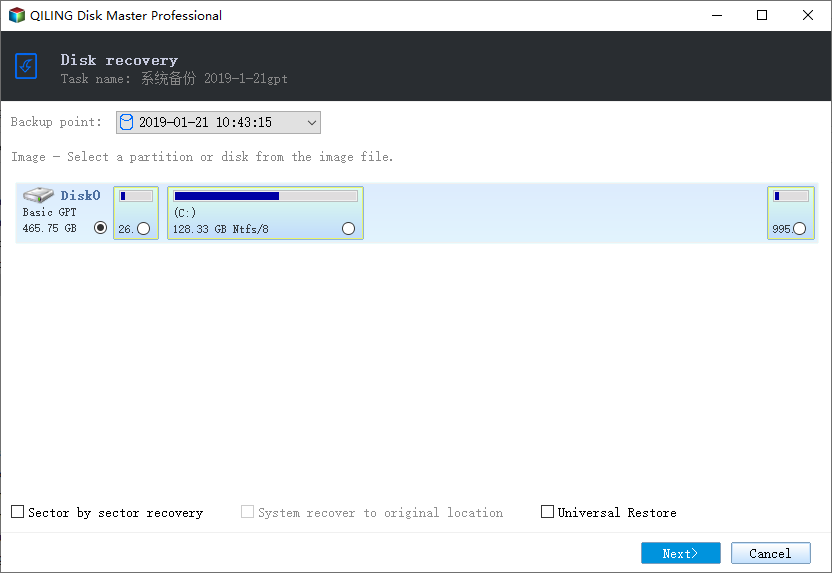
And select the target location to restore your Windows.
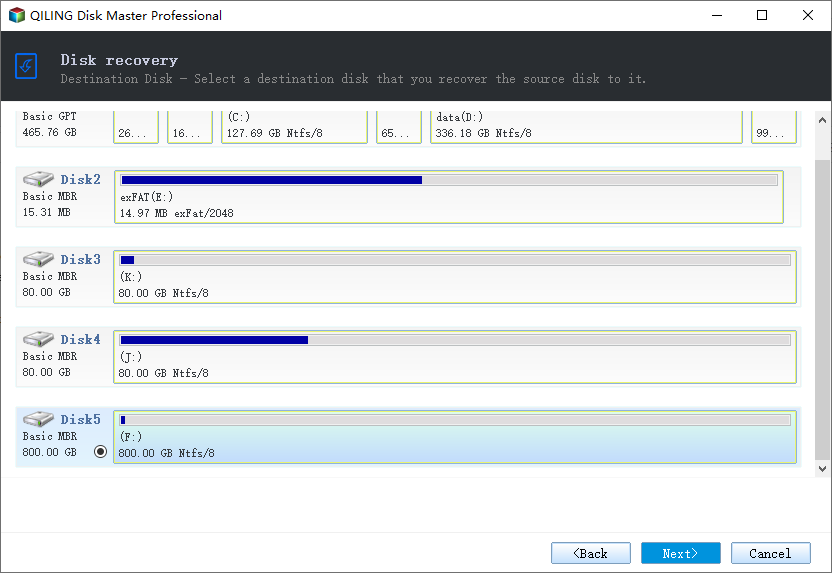
Step 3. Then click "Proceed" to start backup recovery.
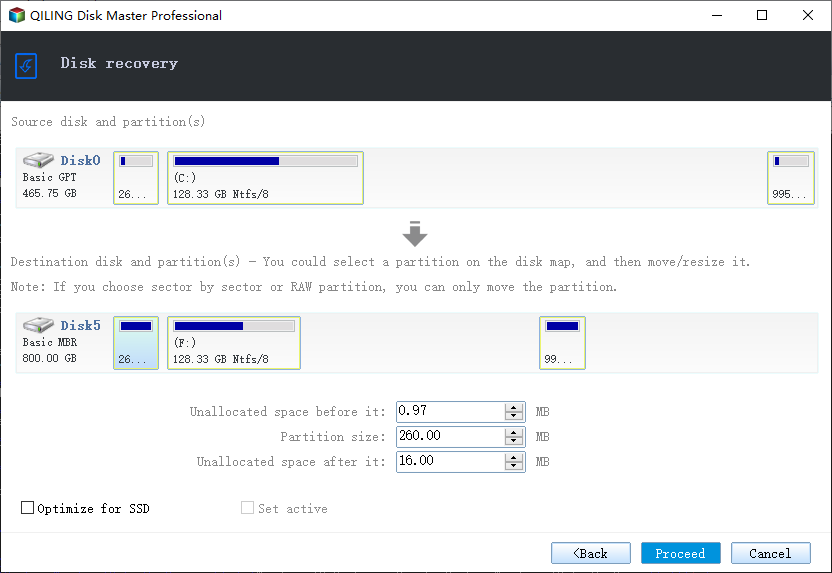
Wait for the process to complete, restart your computer and then you should be able to run Windows OS on your computer again.
You May Also Be Interested: FAQs About Windows Restore Point
On this page, we explained that is Windows Restore Point and how to create and use it. Here we also collected some questions that are related to Windows Restore Point, and if you have the same doubts, check and find answers here.
1. How do I find an earlier restore point? [View restore points windows 10]
- Press Windows + R keys, type rstrui in the Run dialog, and click "OK".
- If you didn't perform System Restore, click "Next".
- If you had previously done a System Restore, check "Choose a different restore point" and click "Next".
- All the Windows restore points that you've created will be listed with a date and time created, description, and type information.
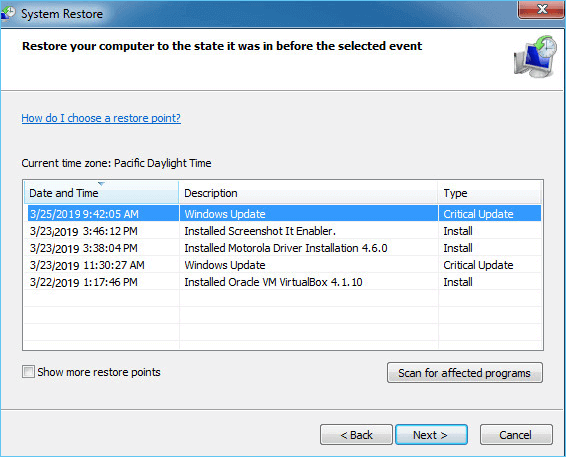
2. Where does Windows 10 save the restore point?
The physical location of the Windows 10 restore point is located in the root directly of your system drive, in the folder - System Volume Information.
To view it:
- Open Control Panel > Recover > File Explorer Options > View Tab.
- Uncheck "Hide protected operating system files" and click "Apply".
- Open File Explorer > C: drive > System Volume Information folder will appear.
- Right-click on the folder > Properties > Security > Advanced.
- Click "Continue" > "Add" > Type the username that to get access rights > "OK"
- Check "Full control" under Basic permissions > "OK".
You can find the System Volume Information folder in the C drive then.
3. Will System Restore Delete My Files?
System Restore takes a "snapshot" of some system files and the Windows registry and saves them as Restore Points. Here is a form that lists the affected and not affected programs and files by running System Restore:
- Installed Windows programs
- System files
- Registry settings
- Windows Updates
- Desktop saved files and folders
For example, if you created a folder or edit a document on your computer desktop. Then you perform a system restore, the OS and all files in the C drive will be reverted to an earlier date. So the files will be lost. For more information, follow Will System Restore Delete My Files.
Related Articles
- Windows 10 Backup and Restore - Full Solutions to Protect System, Data and Applications
- [Solved] Upgrade or Clone PS3/PS4 Hard Drive to a Larger Drive
- How to Clone C Drive to SSD in Windows 10
- How to Backup Windows 10 with [1] Qiling Backup and [2] File History
- [Solved] This Application Was Unable to Start Correctly (Error Code: 0xc000007b)